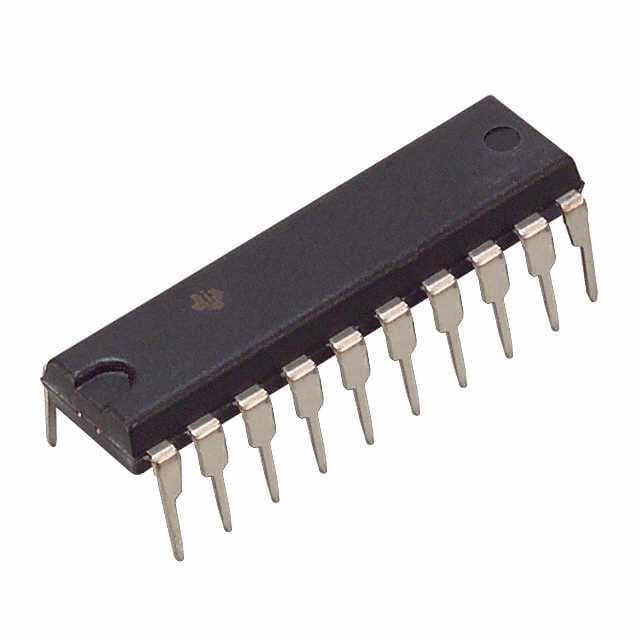CD74AC623E
Product Overview
- Category: Integrated Circuit
- Use: Data Storage and Transfer
- Characteristics: High-speed, Low-power, 8-bit Bus Transceiver
- Package: DIP (Dual In-line Package)
- Essence: The CD74AC623E is a versatile integrated circuit that facilitates bidirectional data transfer between two buses. It operates at high speeds while consuming low power, making it suitable for various applications.
- Packaging/Quantity: Available in tubes or reels, with varying quantities depending on the supplier.
Specifications
- Supply Voltage: 2V to 6V
- Operating Temperature Range: -40°C to +85°C
- Input/Output Compatibility: TTL, CMOS
- Propagation Delay: 5ns (typical)
- Output Drive Capability: ±24mA
- Number of Pins: 20
Detailed Pin Configuration
The CD74AC623E has a total of 20 pins, which are assigned specific functions as follows:
- A0: Input/Output pin for bus A, bit 0
- A1: Input/Output pin for bus A, bit 1
- A2: Input/Output pin for bus A, bit 2
- A3: Input/Output pin for bus A, bit 3
- A4: Input/Output pin for bus A, bit 4
- A5: Input/Output pin for bus A, bit 5
- A6: Input/Output pin for bus A, bit 6
- A7: Input/Output pin for bus A, bit 7
- GND: Ground (0V)
- B7: Input/Output pin for bus B, bit 7
- B6: Input/Output pin for bus B, bit 6
- B5: Input/Output pin for bus B, bit 5
- B4: Input/Output pin for bus B, bit 4
- B3: Input/Output pin for bus B, bit 3
- B2: Input/Output pin for bus B, bit 2
- B1: Input/Output pin for bus B, bit 1
- B0: Input/Output pin for bus B, bit 0
- OE: Output Enable (active low)
- DIR: Direction Control
- VCC: Supply Voltage
Functional Features
- Bidirectional data transfer between two buses (A and B)
- High-speed operation with low power consumption
- TTL and CMOS compatible inputs and outputs
- Output drive capability of ±24mA allows direct connection to other devices
- Output enable and direction control pins provide flexibility in controlling data flow
Advantages and Disadvantages
Advantages
- High-speed operation enables efficient data transfer
- Low power consumption helps conserve energy
- Versatile compatibility with TTL and CMOS devices
- Robust output drive capability allows direct connection to various components
Disadvantages
- Limited number of input/output pins restricts the size of data that can be transferred simultaneously
- Requires careful consideration of signal timing due to propagation delay
Working Principles
The CD74AC623E operates based on a bidirectional transceiver principle. It allows data to flow bidirectionally between two buses (A and B) depending on the state of the direction control pin (DIR). When DIR is high, data flows from bus A to bus B, and when DIR is low, data flows from bus B to bus A. The output enable pin (OE) controls the tri-state outputs, enabling or disabling the data transfer.
Detailed Application Field Plans
The CD74AC623E finds applications in various fields where bidirectional data transfer is required. Some potential application areas include:
- Data communication systems
- Microcontroller interfacing
- Memory modules
- Industrial automation
- Automotive electronics
Detailed and Complete Alternative Models
- SN74AC623: Similar functionality with minor variations in specifications
- 74HC623: CMOS compatible alternative with different voltage range
- CD74HCT623: High-speed CMOS alternative with TTL compatibility
These alternative models offer similar functionality to the CD74AC623E but may have differences in operating characteristics and pin configurations.
In conclusion, the CD74AC623E is a versatile integrated circuit that facilitates bidirectional data transfer between two buses. Its high-speed operation, low power consumption, and compatibility with TTL and CMOS devices make it suitable for various applications in data storage and transfer.
Lista 10 Vanliga frågor och svar relaterade till tillämpningen av CD74AC623E i tekniska lösningar
Sure! Here are 10 common questions and answers related to the application of CD74AC623E in technical solutions:
Q: What is CD74AC623E? A: CD74AC623E is a type of integrated circuit (IC) that functions as an octal bus transceiver with 3-state outputs.
Q: What is the purpose of CD74AC623E? A: CD74AC623E is used to enable bidirectional transfer of data between two buses, making it useful for applications where data needs to be transmitted in both directions.
Q: What voltage levels does CD74AC623E support? A: CD74AC623E supports a wide range of voltage levels, typically from 2V to 6V.
Q: How many bits can CD74AC623E handle? A: CD74AC623E is an octal transceiver, meaning it can handle 8 bits of data.
Q: Can CD74AC623E handle high-speed data transmission? A: Yes, CD74AC623E is designed to operate at high speeds, making it suitable for applications that require fast data transfer.
Q: Does CD74AC623E have built-in protection features? A: Yes, CD74AC623E has built-in ESD (electrostatic discharge) protection, which helps safeguard the IC against damage from static electricity.
Q: Can CD74AC623E be used in both digital and analog circuits? A: CD74AC623E is primarily designed for digital circuits, but it can also be used in some analog applications depending on the specific requirements.
Q: What is the power consumption of CD74AC623E? A: CD74AC623E has low power consumption, making it energy-efficient and suitable for battery-powered devices.
Q: Can CD74AC623E be cascaded to handle more than 8 bits of data? A: Yes, multiple CD74AC623E ICs can be cascaded together to handle larger data widths by connecting the output of one IC to the input of another.
Q: What are some common applications of CD74AC623E? A: CD74AC623E is commonly used in various applications such as data communication systems, memory interfaces, bus arbitration, and general-purpose digital logic circuits.
Please note that these answers are general and may vary depending on the specific implementation and requirements of your technical solution.


